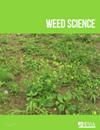Critical Period of Weed Control in an Interseeded System of Corn and Alfalfa
IF 2.1
2区 农林科学
Q2 AGRONOMY
引用次数: 1
Abstract
Abstract Alfalfa (Medicago sativa L.) hectares in Michigan are declining partly due to reliance on corn (Zea mays L.) silage as a continuous feed source. By interseeding corn and alfalfa, farmers can replace the low alfalfa yield in the establishment year with corn silage while simultaneously establishing alfalfa. A randomized split-block field study was conducted in East Lansing, MI, over 3 yr (2019 to 2021) to determine the critical period of weed control (CPWC) in the interseeded corn and alfalfa system using two corn hybrids with differing leaf architecture (pendulum vs. upright). Whole plots were assigned to corn hybrids interseeded with alfalfa, and subplots were assigned to a surrogate weed, Japanese millet [Echinochloa esculenta (A. Braun) H. Scholz], for the duration of competition treatments. Weed-free and weedy plots were included as controls. At the end of the interseeding year, corn was harvested, while alfalfa was harvested the following year. The CPWC is made up of two components: the critical timing of weed removal (CTWR) and the critical weed-free period (CWFP). Corn hybrid had no impact on the CTWR or CWFP for interseeded corn or alfalfa. Averaged across hybrids, the CTWR was 303 growing degree days (GDD), and CWFP was estimated to be greater than the study duration. The CTWR in the first cutting of alfalfa was estimated to be 369 GDD. The CWFP was estimated to be 394 GDD for a 5% acceptable yield loss for the first alfalfa cutting. Identification of the CPWC in the interseeded system will increase adoption and interest in other interseeded systems that can mitigate potential negative environmental and economic impacts of monoculture agriculture.玉米与苜蓿杂交系统杂草防治的关键时期
摘要:美国密歇根州紫花苜蓿(Medicago sativa L.)种植面积正在减少,部分原因是对玉米(Zea mays L.)青贮饲料的依赖。通过玉米和苜蓿的间种,农民可以在种植苜蓿的同时,用玉米青贮代替立种年的低产苜蓿。在密歇根州东兰辛进行了一项为期3年(2019年至2021年)的随机分块田间研究,以确定玉米和苜蓿杂交系统中杂草控制的关键时期(CPWC),该研究使用了两种叶片结构不同的玉米杂交种(摆叶与直立叶)。在竞争处理期间,整块地分配给与苜蓿杂交的玉米杂交种,小块地分配给替代杂草谷子[Echinochloa esculenta (a . Braun) H. Scholz]。无杂草样地和杂草样地作为对照。在间播年结束时,收获玉米,而第二年收获苜蓿。CPWC由两部分组成:除草关键时间(CTWR)和无草关键时间(CWFP)。杂交玉米对杂交玉米和苜蓿的CTWR和CWFP无显著影响。杂交组合的平均CTWR为303生长度日(GDD),估计CWFP大于研究持续时间。首次刈割紫花苜蓿的CTWR估计为369 GDD。CWFP估计为394 GDD,第一次紫花苜蓿切割可接受的产量损失为5%。在杂交系统中确定CPWC将增加对其他杂交系统的采用和兴趣,这些系统可以减轻单一农业对环境和经济的潜在负面影响。
本文章由计算机程序翻译,如有差异,请以英文原文为准。
求助全文
约1分钟内获得全文
求助全文
来源期刊

Weed Science
农林科学-农艺学
CiteScore
4.60
自引率
12.00%
发文量
64
审稿时长
12-24 weeks
期刊介绍:
Weed Science publishes original research and scholarship in the form of peer-reviewed articles focused on fundamental research directly related to all aspects of weed science in agricultural systems. Topics for Weed Science include:
- the biology and ecology of weeds in agricultural, forestry, aquatic, turf, recreational, rights-of-way and other settings, genetics of weeds
- herbicide resistance, chemistry, biochemistry, physiology and molecular action of herbicides and plant growth regulators used to manage undesirable vegetation
- ecology of cropping and other agricultural systems as they relate to weed management
- biological and ecological aspects of weed control tools including biological agents, and herbicide resistant crops
- effect of weed management on soil, air and water.
 求助内容:
求助内容: 应助结果提醒方式:
应助结果提醒方式:


